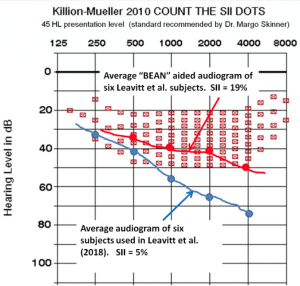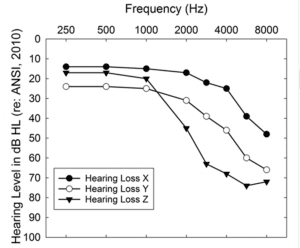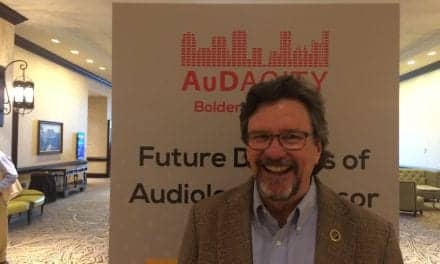Letters | April 2019 Hearing Review
Another comment by Mead Killion on the PSAP findings of Leavitt et al (2018) and Humes et al (2017).
Dear Editor:
Humes1 has provided an eloquent letter to the editor (February 2019 HR) on the article by Leavitt, Bentler, & Flexer.2 I would like to add to the discussion the expected unaided and aided word recognition scores on NU-6 for each audiogram.

Figure 1. Average audiogram of Leavitt et al2 study unaided (blue) ad with a PSAP having 25 dB high-frequency gain.
The estimated results with the audiogram of Leavitt et al. Leavitt et al2 observed that the average subjects used in the Humes et al3 study (summarized4 in the May 2017 HR) had only a mild loss based on the PTA average (500, 1000, and 2000 Hz). For their study, they chose 6 subjects with a moderate 57 dB PTA, as shown in Figure 1.
The unaided SII for the average subject in their study is 5% (5 speech-cue dots).5 Adding 23 dB of high-frequency gain brings only 15 more speech cue dots into audibility, for a total SII of only 20%. (Note: A 23 dB high-frequency gain is typical of modern personal sound amplification products (PSAPs). In particular, it is the gain provided by the Etymotic “QSA BEAN,” one of the PSAPs included in the Leavitt et al2 study.)
Aided or unaided, the subjects in the Leavitt et al study would not be able to carry on a conversation at normal speech levels: the corresponding predicted NU-6 word scores are 5% unaided and 21% aided. They demonstrated that a typical PSAP would be insufficient for their subjects, which seems self-evident. Not surprisingly, these subjects were already long-time hearing aid wearers. They had relatively rare audiograms, however; an examination of the Ciletti and Flamme6 report reveals that the unaided (blue) curve in Figure 1 corresponds to the D78 audiogram in their classification, which represents 0.7% of the population according to the NHANES data Ciletti and Flamme used.
The estimated results with the audiograms of Humes et al. The three audiograms chosen by Humes et al3 were described as “among the most common audiometric configurations, used to pre-match the hearing aids for the ‘consumer decides/over-the-counter participants’ to NAL-NL2 targets.” These three typical audiograms were based on the Ciletti and Flamme report,6 as shown in Figure 2. Examination of the latter report indicates that these three audiograms represent 15-20% of the population at large.
The three audiograms in Figure 2 had a mild PTA of 17, 27, and 27 dB HL for Audiograms X, Y, and Z, respectively. In this case, a count-the-dots SII analysis5 (not shown) shows the “worst-case” sloping-loss Audiogram Z would have an unaided SII of only 50% for a 45 dB HL, which would provide an expected NU-6 word score of 60%. For a PSAP with 23 dB high-frequency gain, the same audiogram would gain 23 of the 50 lost “SII” dots for an aided total SII of 73% for a 45 dB HL presentation. The expected NU-6 word score for Audiogram Z with the typical PSAP would rise to 90%. Clearly a good PSAP should provide improved hearing in this case. (Note: The conversion from SII to NU-6 word scores is based on the “NU-6 words” curve in Figure 3 of Killion & Mueller.5)
Summary. Humes et al3 was the first double-blind-with-placebo study of fitting methods. Their “Placebo” fitting was a hearing aid programmed to deliver the same eardrum response as the open ear. Their summary was: Hearing aids are efficacious in older adults whether they were obtained with “Audiologist Best Practices” (AB) or “Consumer Decides” (CD) service-delivery models. The “CD” model of OTC service delivery yielded only slightly poorer outcomes than the “AB” model. Efficacious OTC models may increase accessibility and affordability of hearing aids for millions of older adults. Purchase price had no effect on outcomes, but a high percentage of those who rejected hearing aids paid the typical price (85%).
This writer agrees.
—Mead C. Killion, PhD, Etymotic Research/Lucid Audio (Dr Killion is founder of Etymotic Research, manufacturer of the Bean device, which was purchased by Lucid Audio in 2018.)
References
-
Humes L. Letters: Hearing loss severity and OTC hearing aids: Larry Humes comments on article by Leavitt, Bentler & Flexer. Hearing Review. 26(2):10-12.
-
Leavitt R, Bentler R, Flexer C. Evaluating select personal sound amplifiers and a consumer-decision model for OTC amplification. Hearing Review. 2018;25(12)[Dec]:10-16.
-
Humes LE, Rogers SE, Quigley TM, Main AK, Kinney DL, Herring C. The effects of service-delivery model and purchase price on hearing-aid outcomes in older adults: A randomized double-blind placebo-controlled clinical trial. Am J Audiol. 2017;26(1):53-79.
-
Humes LE, Rogers SE, Quigley TM, Main AK, Kinney DL, Herring C. The effectiveness of two service-delivery models in older adults: A randomized double-blind placebo-controlled clinical trial. Hearing Review. 2017;24(5);12-19.
-
Killion MC, Mueller HG. Twenty years later: A NEW Count-The-Dots method. Hear Jour. 2010;63(1):12-17.
-
Ciletti L, Flamme GA. Prevalence of hearing impairment by gender and audiometric configuration: results from the National Health and Nutrition Examination Survey (1999-2004) and the Keokuk County Rural Health Study (1994-1998). J Am Acad Audiol. 2008;19(9):672-85.







The problem is nobody wants hearing aids. They have to be sold. Talented people who are good at persuading others demand payment above the average worker. They will also need to be smart enough to handle the clinical aspects of dispensing hearing aids.
Japan has a robust OTC program. You can buy hearing aids in a blister pack at the bait store. They have a satisfaction rate of about 15%. Much lower than that of the us.
Let’s not forget that 3M got into the hearing aid business in the 90’s. They weren’t ready for all of the returns. One of their top executives said they made more money from post-it notes. Your research won’t matter. I liken it to the global warming crowd. Your lies will take care of themselves in do time.
I am very sad that people like you in our industry are willing to spread the lies of big corporations for Nefarious reasons. I will still be around when the likes of Bowes and Samsung understand that you shouldn’t get involved with things you don’t understand. Just ask 3M, the largest corporation in the US.